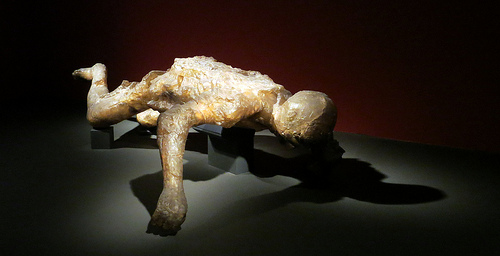Life And Death In Pompeii at The British Museum
The events that followed the eruption of Mount Vesuvius in AD79 have captured the imaginations of millions of people all over the world. In a mere 24 hours all life in the Italian cities of Pompeii and Herculaneum ceased as ash rained down from the skies and suffocated everyone and everything. It has previously only been possible to appreciate the devastation that the eruption brought by visiting what remains of the towns and unfortunately a trip to Italy is not something that everyone can stretch to. This is why the exhibition that is running from the end of March through to September 2013 is so extraordinary. This is the first major public exhibition in the UK that focuses on what happened in those catastrophic twenty four hours all those years ago. It has been almost forty years since there has been anything remotely similar in the city and it looks set to draw visitors from far and wide.

The exhibition has been brought to London with the collaboration of the Archaeological Superintendency of Naples and Pompeii, who have allowed the transportation of more than two hundred and fifty incredible artefacts, many of which have never been seen outside of their home country. The exhibition is focussed on the life of the town, the people that lived there and what happened to them on that one eventful day in history.
Pompeii and Herculaneum
Both of these cities are located on the Bay of Naples in the South of Italy, both were suffocated as a result of an incredibly large eruption of nearby Mount Vesuvius. Aside from ending all life in both of the cities the falling ash also preserved the city just as it was all those centuries ago, remaining untouched until almost 1700 years later when the sites were discovered by archaeologists.
The discoveries that have been made in both cities have provided more information to date, on daily life in the Roman Empire than any other archaeological site. Herculaneum was located on the coast, peaceful and scenic whereas Pompeii was a bustling town filled with businesses and industry. Both offer artefacts and information that is unparalleled in terms of discovering about the real people that lived, and died there.
What You Can Expect
Visitors to the exhibition should expect to be amazed by the quality and diversity of the artefacts that are on display. They should also expect to feel a bond with the people depicted in the exhibition, after all these were the real people of the town, people just like you. These are not the emperors and the gladiators, but the bakers, the tradesmen and the housewives and children of the towns, as can be seen by the perfectly preserved baby’s crib which still rocks gently as it once did. Yes there are emotive exhibits, casts of the families that huddled together as the ash fell. But there are also exhibits of exquisite beauty, complete and intact looking no different than when they were on display in their original locations, before the day that changed the world.

